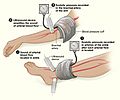Peripheral artery disease facts for kids
Peripheral artery disease, often called PAD, is a health problem that affects the blood vessels in your legs. These blood vessels are like tiny tubes that carry blood to your muscles and skin. When someone has PAD, these tubes can get narrow or blocked. This can make it hard for blood to flow properly to the legs and feet.
When blood flow is not good, it can cause pain in the legs, especially when walking or exercising. This pain usually goes away when the person rests. If PAD becomes more serious, it can cause sores or wounds on the feet and toes that don't heal easily. Sometimes, if the problem is very serious, doctors might need to do surgery to help blood flow better.
PAD is also known by other names like peripheral artery occlusive disease (PAOD) or peripheral vascular disease (PVD).
Contents
What Causes PAD?
PAD happens when a substance called plaque builds up inside the arteries. Arteries are the blood vessels that carry oxygen-rich blood from your heart to the rest of your body. Plaque is made of fat, cholesterol, and other things in your blood.
How Plaque Forms
When plaque builds up, it makes the arteries narrower and harder. This process is called atherosclerosis. Think of it like rust building up inside a water pipe, making it harder for water to flow through. Over time, this narrowing can block the artery completely.
Risk Factors for PAD
Some things can make it more likely for someone to get PAD. These are called risk factors. They include:
- Smoking: This is one of the biggest risk factors. Chemicals in tobacco can damage blood vessels.
- Diabetes: This is a condition where the body has too much sugar in the blood. High blood sugar can harm blood vessels over time.
- High blood pressure: When the force of blood against artery walls is too high, it can damage them.
- High cholesterol: Too much bad cholesterol in the blood can lead to plaque buildup.
- Older age: PAD is more common in older adults.
- Family history: If someone in your family has had PAD or heart disease, you might be more likely to get it.
Symptoms of PAD
The most common symptom of PAD is leg pain when walking or exercising. This pain is called claudication.
Claudication Explained
Claudication usually feels like a cramp, ache, or tiredness in the leg muscles. It often happens in the calf, thigh, or buttock. The pain starts during activity and stops after a few minutes of rest. This is because when you exercise, your muscles need more blood. If the arteries are narrowed, they can't deliver enough blood, causing pain.
Other Signs of PAD
Besides pain, other signs of PAD can include:
- Numbness or weakness in the leg.
- Coldness in the lower leg or foot, especially compared to the other leg.
- Sores on the toes, feet, or legs that heal very slowly or not at all.
- A change in the color of the legs (they might look pale or bluish).
- Shiny skin on the legs.
- Slower growth of toenails.
- Less hair growth on the legs.
- No pulse or a very weak pulse in the legs or feet.
Sometimes, people with PAD might not have any symptoms at all, especially in the early stages.
How Doctors Find PAD
Doctors use different ways to find out if someone has PAD.
Ankle-Brachial Index (ABI)
One common test is called the ankle-brachial index (ABI). This test compares the blood pressure in your ankle to the blood pressure in your arm.
- A doctor uses a regular blood pressure cuff and a special ultrasound device to measure blood pressure in both places.
- If the blood pressure in the ankle is much lower than in the arm, it can mean there's a blockage in the leg arteries.
Other Tests
Doctors might also use other tests, such as:
- Ultrasound: This uses sound waves to create pictures of blood flow in the arteries.
- Angiography: This is a special X-ray test where a dye is injected into the blood vessels to make them show up clearly.
Treating PAD
The main goals of treating PAD are to reduce symptoms, improve quality of life, and prevent the condition from getting worse.
Lifestyle Changes
Doctors often recommend important lifestyle changes first:
- Quitting smoking: This is the most important step for smokers.
- Regular exercise: A supervised walking program can help improve blood flow and reduce pain.
- Healthy eating: Eating foods low in saturated fat, trans fat, and cholesterol can help.
- Managing other conditions: Keeping blood pressure, cholesterol, and blood sugar levels under control is very important.
Medications
Doctors might prescribe medicines to help with PAD. These can include:
- Medicines to lower cholesterol.
- Medicines to lower blood pressure.
- Medicines to help prevent blood clots.
- Medicines to help improve blood flow.
Procedures and Surgery
In some cases, if PAD is severe and lifestyle changes and medicines aren't enough, doctors might suggest procedures or surgery:
- Angioplasty: A tiny balloon is inserted into the narrowed artery and inflated to open it up. Sometimes a small mesh tube called a stent is left behind to keep the artery open.
- Bypass surgery: A doctor uses a healthy blood vessel from another part of the body (or a synthetic tube) to create a new path for blood to flow around the blocked artery.
Living with PAD
People with PAD can live full lives by working closely with their doctors and making healthy choices. Regular check-ups are important to manage the condition and prevent problems. Taking care of your feet is also very important, especially if you have sores or wounds.
Images for kids
See also
 In Spanish: Enfermedad vascular periférica para niños
In Spanish: Enfermedad vascular periférica para niños




